
The Origin
In the beginning there was Gene
Roddenberry...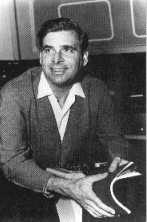
The story of Star Trek rightly begins August 19, 1921, in El Paso
Texas, where Eugene Wesley Roddenberry was born. A sickly but imaginative
child, Roddenberry read voraciously. As he grew older, both his health and
imagination began to improve. Bitten early by the writing bug, he served
as a B-17 bomber pilot during World War II, using his off-duty moments to
pen aviation magazine articles and poetry, some of which he sold to the New
York Times.
After the war, Roddenberry became an international airline pilot for Pan
American World Airways, but the urge to write never left him. He continued
to produce magazine articles and dreamt of going to Hollywood to launch a
career as a writer.
In 1949, he gave into his dream, he quit his pilot's job and moved to Los
Angeles, hoping to write for the new medium of television. In the meantime,
he paid the rent by joining the Los Angeles Police Department. Even there
his talent for stringing words together didn' t go unnoticed, and he began
writing speeches for the Chief of Police William Parker.
Eventually, Roddenberry procured an agent and began selling scripts to TV
series. Soon after, when he realized that he was earning far more as a script
writer than a cop, he turned in his badge and began writing full-time. A
number of scripts sales followed; "Dragnet", "Playhouse 90", "Naked City",
and "Doctor Killdare", among others. In due time, he landed a job as a story
editor on "Have Gun, Will Travel"; his script for that series episode "Helen
of Abajnian" won him the prestigious Writer's Guild Award.
In 1959, he turned to producing, for as he said, "it became apparent to me
that if you want the film to reflect accurately what you felt when you wrote
the script, then you have to produce it too." His first few pilots failed
to sell (one of them, "333 Montgomery", starred DeForrest Kelly). Finally,
he sold the Marine Corps drama "The Lieutenant", which featured Gary Lockwood
and Robert Vaughn. (Actors Leonard Nimoy, Nichelle Nichols, Walter Keonig,
Grace Lee Whitney, and Majel Barret all guest-starred on the series.)
"The Lieutenant" only lasted one season, and it was gearing down, Roddenberry's
thoughts turned to his next series and the future. At that time, he was greatly
influenced by a recent nonfiction book, Arthur C. Clarke's "Profiles of the
Future", which discussed "space drive", "warped space" and "instantaneous
transportation", Inspired, Roddenberry decided that his next series would
be a science fiction show. "Now", he said, "perhaps I'd be able to talk about
love, war, nature, God, sex.....and maybe the TV censors would let it pass
because it all seemed so make-believe."
Thus Star Trek was born. Roddenberry's original concept was that of a "wagon
train to the stars", and included the Starship Yorktown plus significantly
different characters from the ones we know today: ship's captain Robert April,
the logical female second-in-command Number One (Majel Barret), navigator
Jose Tyler, captain's yeoman J. M. Colt, and elderly Dr. Phillip Boyce. And
as for Mr. Spock....
According to Samuel A. Peebles, writer of the episode "Where No Man Has Gone
Before", "Spock" was (originally) a red-skinned creature with fiery ears,
who had a plate in the middle of his stomach. He didn't eat or drink, but
he fed upon any form of energy that struck his plate in his stomach. I told
Gene that I thought this very effectively destroyed him as an interesting
character because he was no longer human and that he should be at least
half-human and have the problems of both sides."
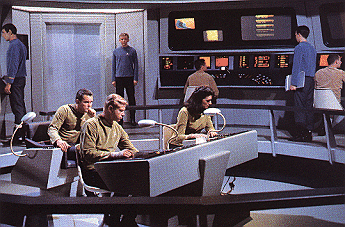 Unfortunately, MGM, who backed "The Lieutenant" didn't think science fiction
would appeal to 1960's viewers. Roddenberry shopped his series concept to
several studios, but all rejected it as too risky and expensive, all except
Desilu, which was actively seeking new projects and signed Roddenberry a
three year deal.
Unfortunately, MGM, who backed "The Lieutenant" didn't think science fiction
would appeal to 1960's viewers. Roddenberry shopped his series concept to
several studios, but all rejected it as too risky and expensive, all except
Desilu, which was actively seeking new projects and signed Roddenberry a
three year deal.
With Desilu's backing, Roddenberry started pitching his new show to the networks.
He began with CBS executives, who, after pumping him for information about
his new science-fiction idea, informed him they already had a more "adult"
science-fiction series in the works, named "Lost In Space". But NBC was
interested, and commissioned a pilot.
The captain's name had been changed from Robert April to Christopher Pike
(and the ship's name from the Yorktown to the Enterprise), but otherwise
the cast of characters adhered to the original format. Roddenberry approached
Lloyd Bridges of "Sea Hunt" fame to play the lead, but when Bridges turned
him down, Jeffrey Hunter was chosen to play Captain Pike. Veteran character
actor John Hoyt was cast as Dr. Phillip Boyce, and Majel Barret as the frosty,
logical Number One.
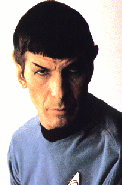 Leonard
Nimoy, of course, had always been Roddenberry's first choice for the part
of Spock; he had wanted to cast the actor as a alien ever since he saw Nimoy
perform in "The Lieutenant". Had Nimoy refused the role, Roddenberry said,
"I probably would've asked Martin Landau. I'd worked with him. I had him
in mind as a possibility."
Leonard
Nimoy, of course, had always been Roddenberry's first choice for the part
of Spock; he had wanted to cast the actor as a alien ever since he saw Nimoy
perform in "The Lieutenant". Had Nimoy refused the role, Roddenberry said,
"I probably would've asked Martin Landau. I'd worked with him. I had him
in mind as a possibility."
When Nimoy was called to meet with Roddenberry, the actor assumed he would
have to compete against others for a role in the new show, and was surprised
to learn otherwise. Say's Nimoy, "Gene showed me around the studio. He showed
me the sets that were being developed and the wardrobe that was being designed.
I began to realize that he was selling me on the idea of being in the series,
unusual for an actor. I figured all I had to do was keep my mouth shut and
I might end up with a good job here."
One thing Roddenberry wanted in his pilot was a green dancing woman, so Majel
Barret was used to screen-test the green makeup that would later be worn
by the female guest star. She recalls, "The makeup they put on me was green
as green can be, but they kept sending out the rushes and we would get it
back the next day, and there I was just as pink and rosy as could possibly
be. So they decided there was not enough green in it, I got greener and greener.
Now, this stuff is hard to get off. I rubbed my face raw. This went on for
three days, until they finally called the lab and said, "What do we have
to do to get this woman's face green?" And they said, "Green? You wanted
it green? We thought it was a mistake, so we've been color correcting!"
Susan Oliver was finally cast as Vina, the female guest star, and the pilot
was shot in nine days at a cost of $630,000, which at the time made it the
most expensive pilot ever produced. Despite the cost, NBC rejected the pilot,
because it was "too cerebral" and lacking in action and adventure. They also
objected to a female second-in-command, and to the guy with the pointed ears,
saying that his demonic appearance might offend religious groups. However,
they liked "The Cage" enough to do an unheard of thing, ask for a second
pilot.
Roddenberry brought in veteran writer Sam Peebles to provide the action-filled
script for "Where No Man Has Gone Before", and started to work on revamping
the series. Jeffry Hunter chose not to continue in the role of Pike, so
Canadian-born William Shatner was eventually cast in his place, and the captain
was given a new name: James T. Kirk.
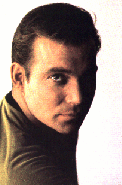 Shatner
had appeared in film, television, and on stage. Two years earlier, he had
played another heroic lead in an unsold pilot, "Alexander the Great", which
he playfully describes as "Combat in drag". But his role as Alexander definitely
influenced his portrayal of Kirk. In contrast to Jeffrey Hunter brooding,
somber performance as Pike, Shatner brought a warmth and likeabiltity to
the role as Enterprise captain. (In an interesting coincidence, Shatner had
worked with Nimoy before, in a 1964 "Man from U.N.C.L.E." episode.) His initial
impression, when Roddenberry showed him "The Cage", was that "it was a very
imaginative and vital idea..... Then a script was written (for the second
pilot), and I made some suggestions that Gene kindly said sometime after
had some import....My general impressions were that it was a wonderful, vital
idea that needed little change."
Shatner
had appeared in film, television, and on stage. Two years earlier, he had
played another heroic lead in an unsold pilot, "Alexander the Great", which
he playfully describes as "Combat in drag". But his role as Alexander definitely
influenced his portrayal of Kirk. In contrast to Jeffrey Hunter brooding,
somber performance as Pike, Shatner brought a warmth and likeabiltity to
the role as Enterprise captain. (In an interesting coincidence, Shatner had
worked with Nimoy before, in a 1964 "Man from U.N.C.L.E." episode.) His initial
impression, when Roddenberry showed him "The Cage", was that "it was a very
imaginative and vital idea..... Then a script was written (for the second
pilot), and I made some suggestions that Gene kindly said sometime after
had some import....My general impressions were that it was a wonderful, vital
idea that needed little change."
Despite NBC's request, Roddenberry was determined to keep the alien, Spock.
He yielded to the request to drop the character Number One, because as he
said, "It seemed to me that we were having so many arguments at this time
that I couldn't save both of them, and so I decided to save the alien character.
And it was time that we gave Mr. Spock the woman's logical unemotional qualities
and kept him on the show. I then married the woman, but obviously, I could
not have legally done it the other way round."
Spock was the only character from the first pilot to appear in the second.
John Hoyt, who had played Dr. Phillip Boyce, was involved in other projects,
so actor Paul Fix was cast as Dr. Piper. Guest stars Sally Kellerman and
Gary Lockwood were cast as psychiatrist Elizabeth Dehener and crewman Gary
Mitchell.
Despite network pressure to have an all-white crew, Roddenberry was determined
that minorities should be represented on the Enterprise. Black actor Lloyd
Haynes was cast as Lieutenant Alden, and George Takei as the Japanese-Filipino
officer, Sulu. According to Takei, "I think it was Gene's vision to have
the makeup of the crew reflect the pluralism of this global society. I think
Gene has often said, "The Starship Enterprise was the Starship Earth in
mirocosm." Takei came away from his first meeting with Roddenberry
�convinced that he wouldn't get the role. He explains, "Roddenberry
came out from behind his desk, and ushered me to a corner of his office where
there was a coffee table and couch setting, so it was a relaxed, comfortable
setting rather than a formal test with a supplicant chair. It was really
a very unusual interview, one on one, and we talked about everything but
my career. Now, generally they ask you about some of the other things you've
done, the other directors you've worked with....Apparently, Gene had done
his homework and knew about that. So we just generally 'shot the
breeze'....Frankly, I walked out of the interview thinking I wasn't right
for the part, and thats why he was carrying on the conversation in the way
that he was."

It was also decided that the ship needed a chief engineer, the actor James
Doohan was called in to read for the role. Roddenberry recalled, "Jimmy Doohan
I had never worked with, but a director brought him in and asked him if he
could do a Scottish accent and he did like an hour and a half of accents
and had us falling on the floor laughing, so there was never any doubt that
he had the job." Roddenberry asked Doohan which accent he preferred, and
Doohan replied, "He's going to be a engineer so he should be a Scotsman."
Doohan has always been fascinated by science and ships. Said he, The writers
of Star Trek found out that I read technical journals. And that's how they
put that into Scotty's character. The character is 99% James Doohan and 1%
accent."
With the cast in place, "Where No Man Has Gone Before", was shot in July
of 1965 at a cost of $330,000. Filming took eight days, post-production several
months. Finally in February1966, word came from the network....Star Trek
would make its television debut in December.
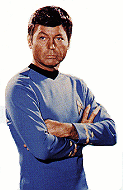 There were changes after the second pilot as well. Roddenberry had always
wanted to cast DeForest Kelly as the doctor, but Kelly had been busy doing
other projects (including pilots for Gene). He remembers, "Gene had never
discussed Star Trek with me at the time except in the commissary one day
before he started (production of the first pilot), and he said, 'De, I've
got two properties.....I think he said for CBS at the time, and that one
of them was a science fiction thing called Star Trek, and the other was "High
Noon". Of course, I had been in a great number of westerns. He said, 'Now,
in the science fiction story there's a very interesting character....He's
an alien and he has pointed ears, and we're going to do him green.' I said
I'll wait for "High Noon"." In addition. NBC felt the audiences wouldn't
buy Kelly in a "good guy" role, as he had played the role of villain too
often (such as the despicable Amos True in "Gunfight at Comanche Creek",
who coolly silences a barking dog by shooting it....A far cry from that lovable
Dr. McCoy) But Roddenberry convinced the network otherwise and, as soon as
the actor became available, cast him as Leonard "Bones" McCoy. Interestingly,
Kelly had worked with Leonard Nimoy before, in an episode of "The Virginian."
He recalls laughingly, (Nimoy) later reminded me of that...I played a drunken
doctor and I let him die."
There were changes after the second pilot as well. Roddenberry had always
wanted to cast DeForest Kelly as the doctor, but Kelly had been busy doing
other projects (including pilots for Gene). He remembers, "Gene had never
discussed Star Trek with me at the time except in the commissary one day
before he started (production of the first pilot), and he said, 'De, I've
got two properties.....I think he said for CBS at the time, and that one
of them was a science fiction thing called Star Trek, and the other was "High
Noon". Of course, I had been in a great number of westerns. He said, 'Now,
in the science fiction story there's a very interesting character....He's
an alien and he has pointed ears, and we're going to do him green.' I said
I'll wait for "High Noon"." In addition. NBC felt the audiences wouldn't
buy Kelly in a "good guy" role, as he had played the role of villain too
often (such as the despicable Amos True in "Gunfight at Comanche Creek",
who coolly silences a barking dog by shooting it....A far cry from that lovable
Dr. McCoy) But Roddenberry convinced the network otherwise and, as soon as
the actor became available, cast him as Leonard "Bones" McCoy. Interestingly,
Kelly had worked with Leonard Nimoy before, in an episode of "The Virginian."
He recalls laughingly, (Nimoy) later reminded me of that...I played a drunken
doctor and I let him die."
Roddenberry also cast Nichelle Nichols in the role of Lieutenant Uhura ("uhuru"
means "freedom" in Swahili). Nichols's first dramatic episode had come three
years earlier, when she had appeared in an episode of "The Lieutenant". She
was singing in England when her agent contacted her about the possibility
of a role in a new science fiction series. She was enjoying her stay in Europe
and refused at first to return to the States. But her agent persisted, and
finally convinced her by paying for a plane ticket home. When Nichols went
to read for Star Trek, there was no part in the script for her, so she read
for the part of Mr. Spock. "We did a nice long reading, a scene that was
several pages long." she recalls, "and when I finished, one of the guys said
' Call down to personnel to see if Leonard Nimoy has signed his contract
yet!"
Grace Lee Whitney, who had appeared in the films "Top Banana" and "Some Like
It Hot", was hired to replace Andrea Dromm as the captain's yeoman. (Whitney
had also appeared in Roddenberry's "Police Story" pilot with DeForest
Kelly.)
Majel barett returned to the show in a different guise, that of nurse Christine
Chapel. NBC executives had not liked barett's portrayal of Number One, so
barett came up with a plan. She bleached her hair blonde and went into
Roddenberry's office. " I sat there talking to his secretary, Penny, and
Gene walked in. He looked at me and Penny, said, 'Good Morning,' and walked
in the door.....I kept talking to Penny, and pretty soon Gene came out again,
put some papers on Penny's desk, sort of smiled at me, turned around, and
walked back into his office. Then the double take happened. He opened the
door and said, 'Majel?' And I said, ' By God, if I could fool you, I can
fool NBC.'"
With the characters in place, Star Trek went into series production, at a
cost to NBC of $180,000 per episode. By August of 1966, Roddenberry had settled
into the role of executive producer, with Gene L. Coon as producer and Robert
Justman as associate producer.
In September of 1966, Roddenberry decided to garner a little advance publicity
by showing the pilot "Where No Man Has Gone Before" to attendees of the world
Science Fiction Convention in Cleveland. Understandably nervous about audience
reaction as his show began, Roddenberry snapped up at a "rather loud" gentleman
to be quiet. And Issac Asimov said, "Yes, you're perfectly right. We will
tone it down." And someone said, "You're dead, you just insulted Issac Asimov."
As it turned out, Asimov took no offense, in fact, he became an enthusiastic
supporter of the show who often corresponded with Roddenberry. The audience's
reaction? A standing ovation.
And on September 8, 1966, at 8:30 P.M. EST, Star Trek Made it's television
debut.....
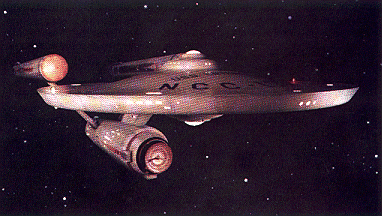
To Boldly Go Where No Man Has Gone Before...